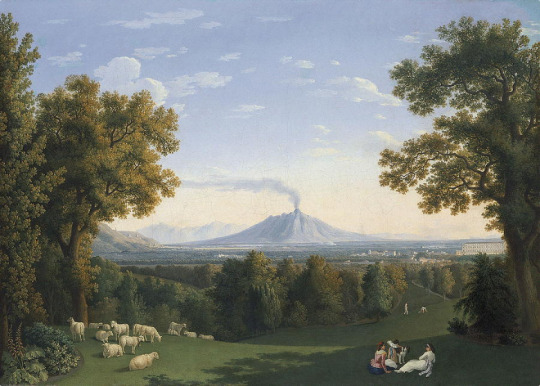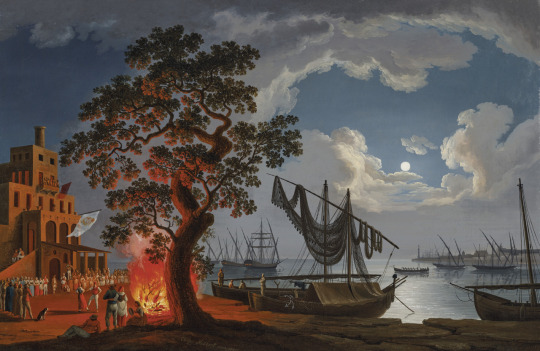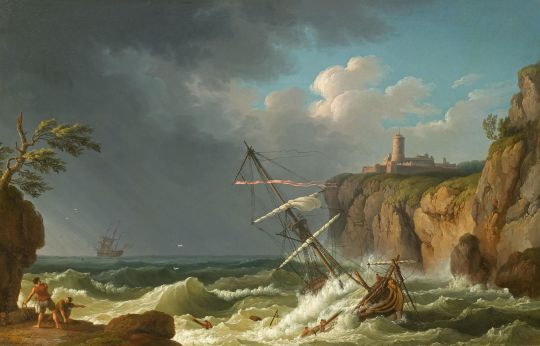#jacob philippe hackert
Explore tagged Tumblr posts
Photo

Arkadische Landschaft von Jacob Philippe Hackert (1829, oil on canvas)
#kunst#kunstwerk#art#artwork#jacob philippe hackert#künstler#artist#landschaft#landscape#wiesen#meadows#felder#fields#bäum#trees#weideland#pastureland#animals#tiere#cattle#rind#vieh#aussicht#view#fluss#tempel#temple#fluss rifer#water#berg
9 notes
·
View notes
Text

A customs house, with dancers and musicians next to a fire, boats in a bay beyond, 1780, Jacob Philipp Hackert
137 notes
·
View notes
Text

Feuerwerk auf der Engelsburg in Rom, ca. 1775
(Fireworks over Castel Sant'Angelo in Rome)
Artist: Jacob Philipp Hackert
#artist#museum#reddit#aethelwulf888#1775#painter#art#jacob philipp hackert#painting#feuerwerk auf der engelsburg in rom#fireworks over castel sant'angelo in rome#neo impressionism
16 notes
·
View notes
Text

Riverside Landscape by Jacob Philipp Hackert
#jacob philipp hackert#art#landscape#riverside#europe#european#romantic#romanticism#bridge#temple#animals#idyllic#picturesque#arcadian#river#rivers
66 notes
·
View notes
Text

View of the Waterfall
Artist: Jacob Philipp Hackert (German, 1737-1807)
Date: 1793
Medium: Oil on canvas
Collection: Private collection
Description
The painting shows a view of the waterfall at Anitrella with goats grazing nearby. This dramatic waterfall landscape was painted following a trip Hackert made through Lazio and Abruzzi in the spring of 1793. Anitrella lies to the southwest of the town of Isola di Liri (called Isola di Sora in Hackert's time) and the 40 meter high cascade is where the river Liri emerges from the foothills of the Abruzzi.
#painting#waterfall#oil on canvas#artwork#landscape#anitrella#goats#italy#jacob philipp hackert#german painter#18th century painting
18 notes
·
View notes
Text

Jacob Philipp Hackert - Landscape With The Palace At Caserta With The Vesuvius
3 notes
·
View notes
Text

4 notes
·
View notes
Text

View of Château Gaillard and the Seine by Jacob Philipp Hackert.
#Jacob Philipp Hackert#arte#history#art#painting#artwork#oil painting#paintings#art history#realism#landscape painting#pintura#artista#escultura#dibujo#france#kunst
5 notes
·
View notes
Text

A Shipwreck, by Jacob Philipp Hackert, 1776
112 notes
·
View notes
Text

Jacob Philipp Hackert, Aeneas and Dido Flee the Storm into a Grotto, c. 1800
#us#i miss u wyd#last one flopped oop#jacob phillip hackert#aeneas and dido flee the storm into a grotto#1800s#romanticism#literary#landscape#landesmuseum hannover#paintings#art history#fine art
20 notes
·
View notes
Text

MWW Artwork of the Day (9/11/23) Jacob Philipp Hackert (German, 1737–1807) The Eruption of Vesuvius (1779) Oil on canvas, 64.5 x 87 cm. Private Collection
Hackert was a landscape painter from Brandenburg, who did most of his work in Italy, and, like many of his German Romantic brethren, did several stunning works featuring eruptions of Mount Vesuvius. The volcano erupted again in 1631, six times in the 18th century, eight times in the 19th century (notably in 1872), and in 1906, 1929, and 1944. There has been no eruption since 1944, and none of the post-79 eruptions were as large or destructive as the Pompeian one.
3 notes
·
View notes
Text
The Dying King at Nemi
“The lake of Nemi is still as of old embowered in woods, where in spring the wild flowers blow as fresh as no doubt they did two thousand springs ago.... Here, in the very heart of the wooded hills, under the abrupt declivity now crested by the village of Nemi, the sylvan goddess Diana had an old and famous sanctuary, the resort of pilgrims from all parts of Latium. It was known as the sacred grove of Diana Nemorensis, that is, Diana of the Wood, or, perhaps more exactly, Diana of the Woodland Glade. Sometimes the lake and grove were called, after the nearest town, the lake and grove of Aricia.... In the sacred grove there grew a certain tree round which at any time of the day, and probably far into the night, a grim figure might be seen to prowl. In his hand he carried a drawn sword, and he kept peering warily about him as if at every instant he expected to be set upon by an enemy. He was a priest and a murderer; and the man for whom he looked was sooner or later to murder him and hold the priesthood in his stead. Such was the rule of the sanctuary. A candidate for the priesthood could only succeed to office by slaying the priest, and having slain him, he retained office till he was himself slain by a stronger or a craftier.

Lake Nemi, depicted in a 1776 painting by Jacob Philipp Hackert. (Source: Jacob Philipp Hackert, CC0, via Wikimedia Commons)
“The post which he held by this precarious tenure carried with it the title of king; but surely no crowned head ever lay uneasier, or was visited by more evil dreams, than his. For year in year out, in summer and winter, in fair weather and in foul, he had to keep his lonely watch, and whenever he snatched a troubled slumber it was at the peril of his life.... The dreamy blue of Italian skies, the dappled shade of summer woods, and the sparkle of waves in the sun, can have accorded but ill with that stern and sinister figure. Rather we picture to ourselves the scene as it may have been witnessed by a belated wayfarer on one of those wild autumn nights when the dead leaves are falling thick, and the winds seem to sing the dirge of the dying year. It is a sombre picture, set to melancholy music—the background of forest shewing black and jagged against a lowering and stormy sky, the sighing of the wind in the branches, the rustle of the withered leaves under foot, the lapping of the cold water on the shore, and in the foreground, pacing to and fro, now in twilight and now in gloom, a dark figure with a glitter of steel at the shoulder whenever the pale moon, riding clear of the cloud-rack, peers down at him through the matted boughs.

The Golden Bough, by J.M.W. Turner (1834).
(Source: J. M. W. Turner, Public domain, via Wikimedia Commons)
“Within the sanctuary at Nemi grew a certain tree of which no branch might be broken. Only a runaway slave was allowed to break off if he could, one of its boughs. Success in the attempt entitled him to fight the priest in single combat, and if he slew him he reigned in his stead with the title of King of the Wood (Rex Nemorensis). According to the public opinion of the ancients the fateful branch was that Golden Bough which, at the Sibyl’s bidding, Aeneas plucked before he essayed the perilous journey to the world of the dead. The flight of the slave represented, it was said, the flight of Orestes; his combat with the priest was a reminiscence of the human sacrifices once offered to the Tauric Diana. This rule of succession by the sword was observed down to the imperial times; for amongst his other freaks Caligula, thinking that the priest of Nemi had held office too long, hired a more stalwart ruffian to slay him; and a Greek traveller, who visited Italy in the age of the Antonines, remarks that down to his time the priesthood was still the prize of victory in a single combat.”
—J. G. Frazer, The Magic Art and the Evolution of Kings, part 1 (The Golden Bough, vol. I, 1911, pp. 2-11.)

Bust of Diana from the Sanctuary of Nemi, 100-150 BCE, marble.
(Source: MumblerJamie, CC BY-SA 2.0 https://creativecommons.org/licenses/by-sa/2.0, via Wikimedia Commons)
#the dying king#nemi#diana#diana nemorensis#sacred grove#paganism#aricia#priest#italy#ancient rome#roman empire#the golden bough vol i#rex nemorensis#king of the wood#sibyl#aeneas#orestes#the golden bough#jg frazer#magic#kingship#kings#tauric diana
1 note
·
View note
Text

A customs house, with dancers and musicians next to a fire, boats in a bay beyond, 1780, Jacob Philipp Hackert
1 note
·
View note
Text

Fireworks over Castel Sant'Angelo in Rome - Jacob Philipp Hackert
3 notes
·
View notes
Photo

The Waterfall at Tivoli, 1785 by Jacob Philippe Hackert
34 notes
·
View notes
